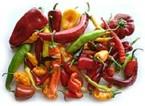Food Science 101: Hot, Hotter, Hottest

Like the last entry in Food Science 101, I learned about today's topic from the great Shirley Corriher, author of CookWise, who spoke at the USPCA National Conference in Atlanta in July.
It has been commonly thought that the heat in chiles came from the veins...No, the seeds! No, the veins!! No, I think it's the skin!!!
It turns out that the real punch in chiles comes from the small glands between the flesh and the "placenta", the thin membrane that lines the flesh. These are the little bubbles you see on the underside when you have cut into a chile. The five capsaicinoid compounds found in varying combinations in chiles and peppers are concentrated in this small space.
So it makes sense that we think the heat comes from the seeds, or the skin, or the veins, since when you cut into a chile, the glands burst and the capsaicinoids are sprayed all over the place!
It follows, then, that if you mince a chile into tiny little bits, and add it to a recipe, it will taste much hotter than if you threw it in whole, or in just a few pieces. Every time you cut into the flesh, you release more of the heat compounds. So if you want to keep things mild, use larger pieces. If you want to blow your mouth open, mince those chiles!











1 Comments:
You've got it right! Smaller is hotter, in general. Of course, certain peppers are hotter than others. If you want fire, try Habanero or Scotch Bonnet. For medium strong heat, try Serranos or Jalapenos. And for more mild, but smokier heat, chipotles and pasillas.
There is already a search feature on the site. Since this is a blogger page, there is a search bar at the very top of the page for searching the site. :-)
Unfortunately, I don't have a Guacamole recipe posted yet, but I'll keep it in mind as an addition. As I said for Gazpacho, Guacamole has as many interpretations as it has cooks making it. There is a basic technique, but you can add lots of things to customize it.
Post a Comment
<< Home